Assembling the FabArm
The FabArm we build on Mechanical Design week had some missing components and some fixtures also broke. So we decided to redo it once again.
Majority of the design for the fab arm were build on mechanical week. So I will not get to those details, but this week we had to make couple of flange shafts to hold up the fab arm. This part was missing when we build the fab arm first time, that is what we did this week.
We took apart a printer for a Aluminum Alloy Rod. We cut the rod for our specific need.
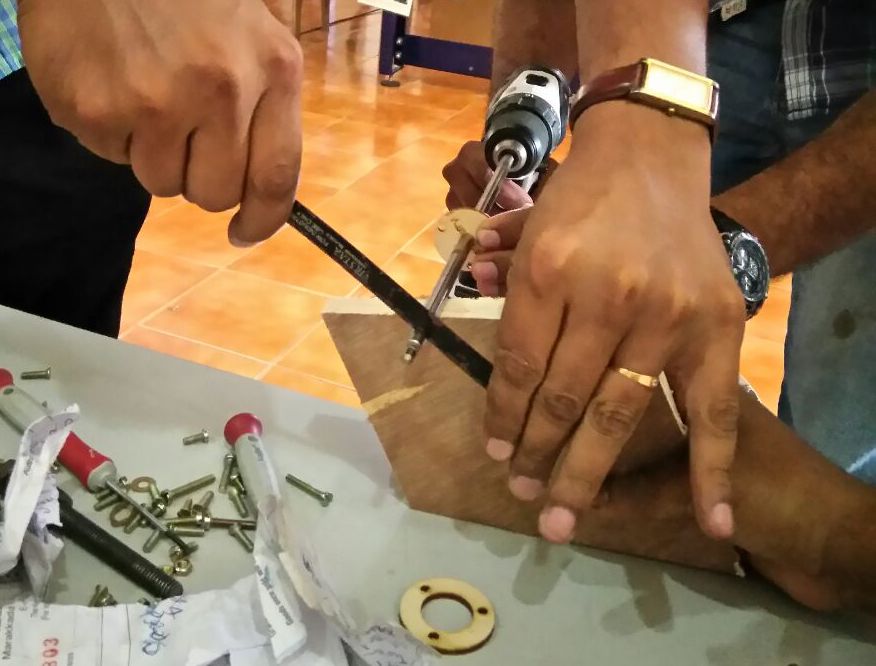
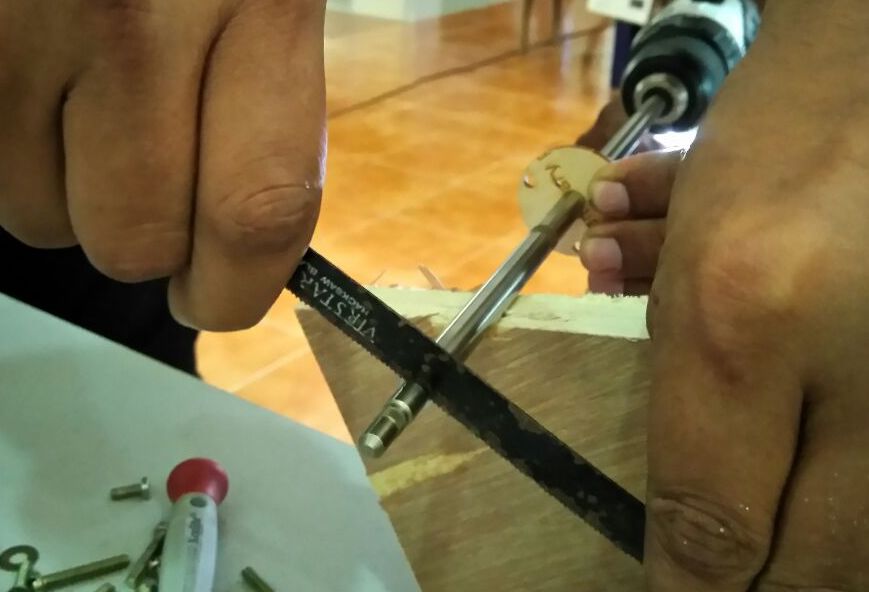
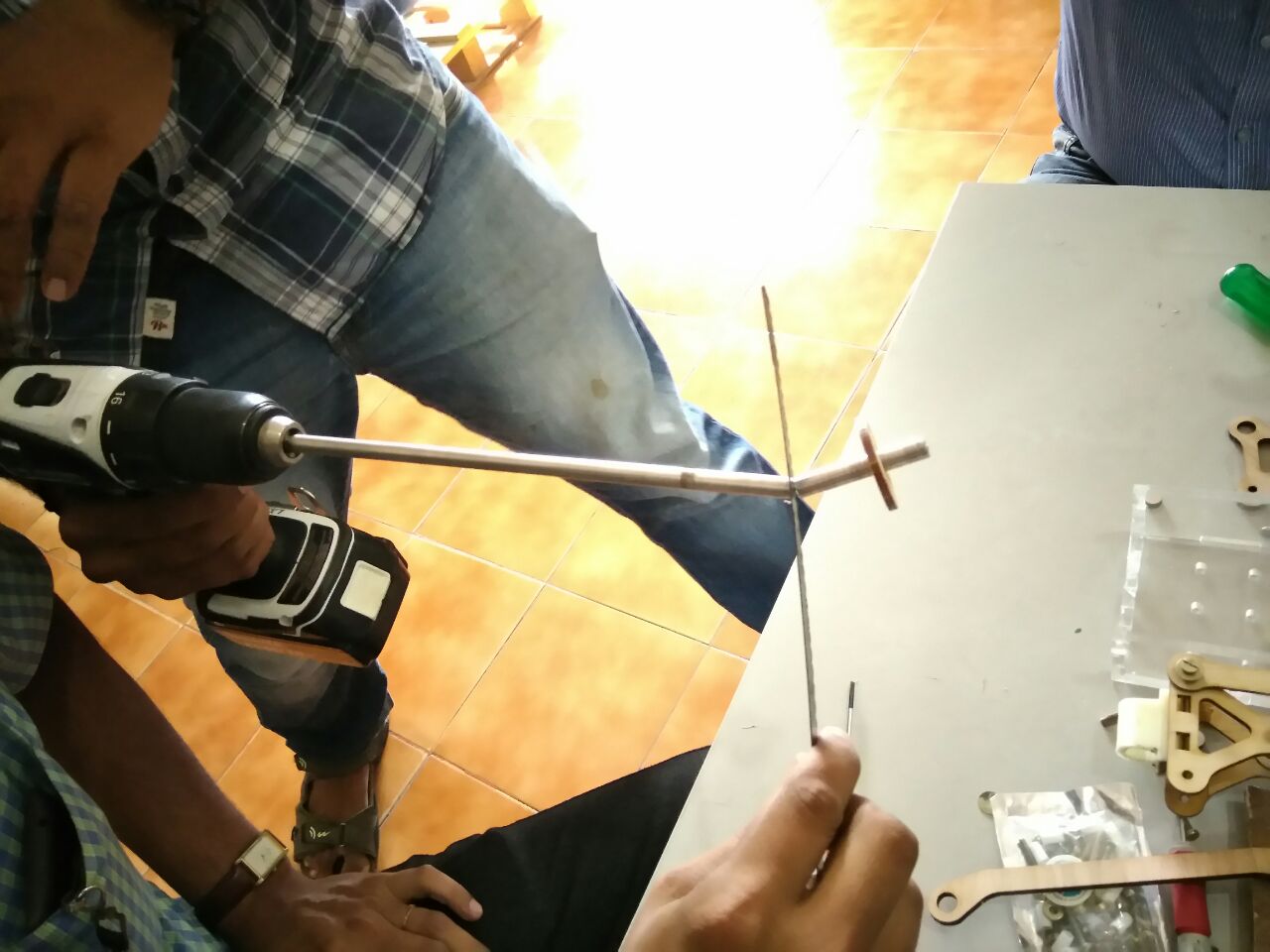
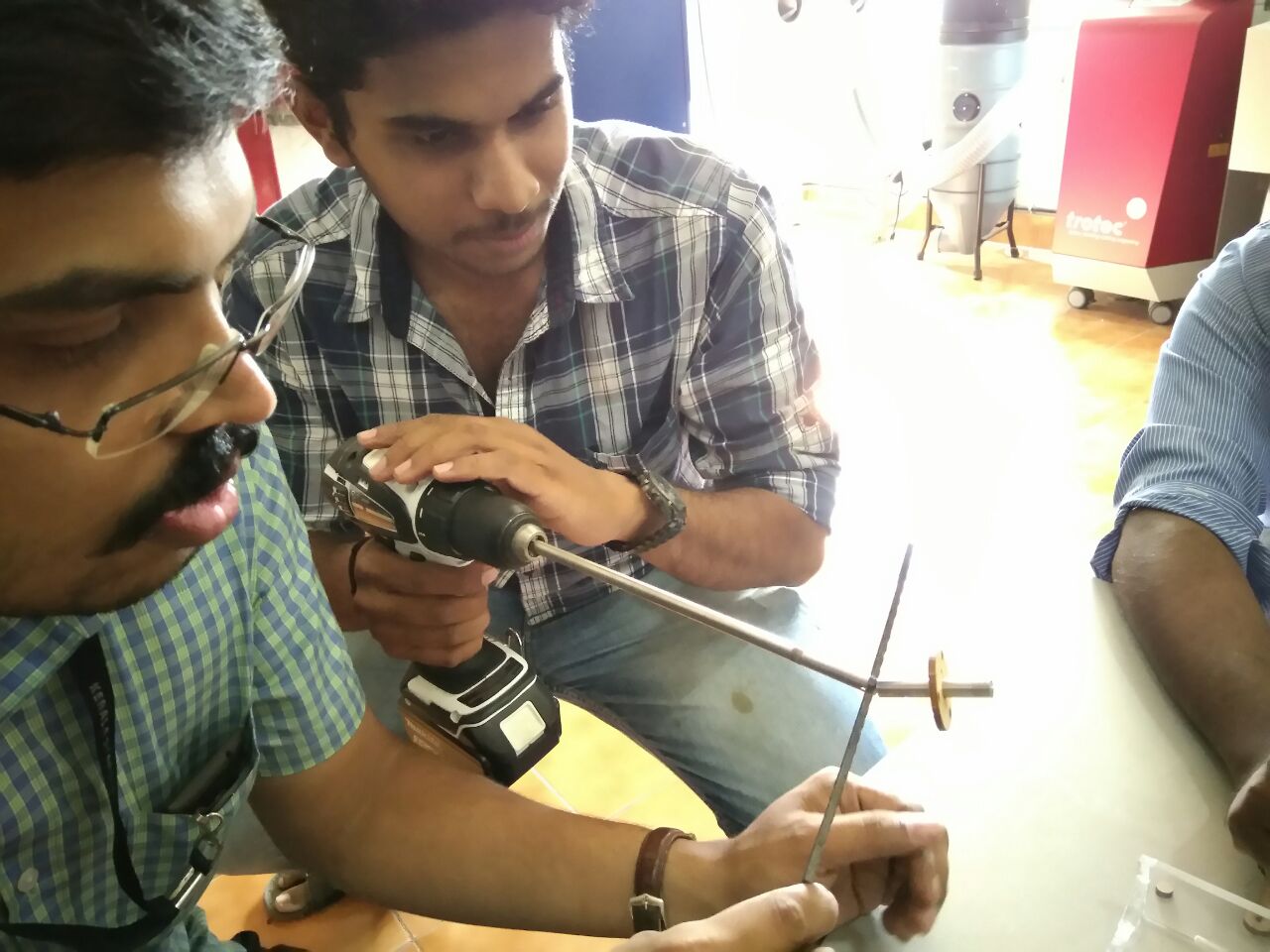
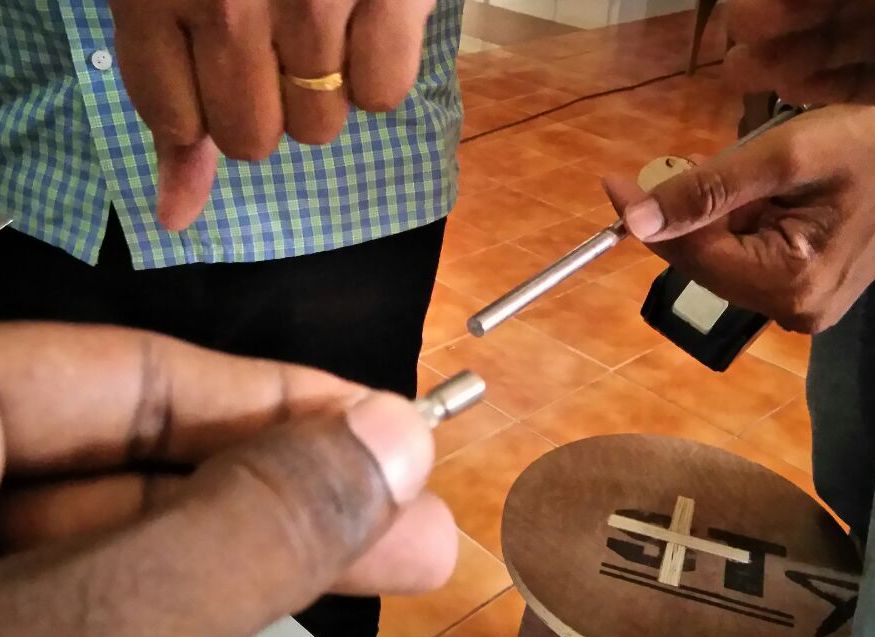
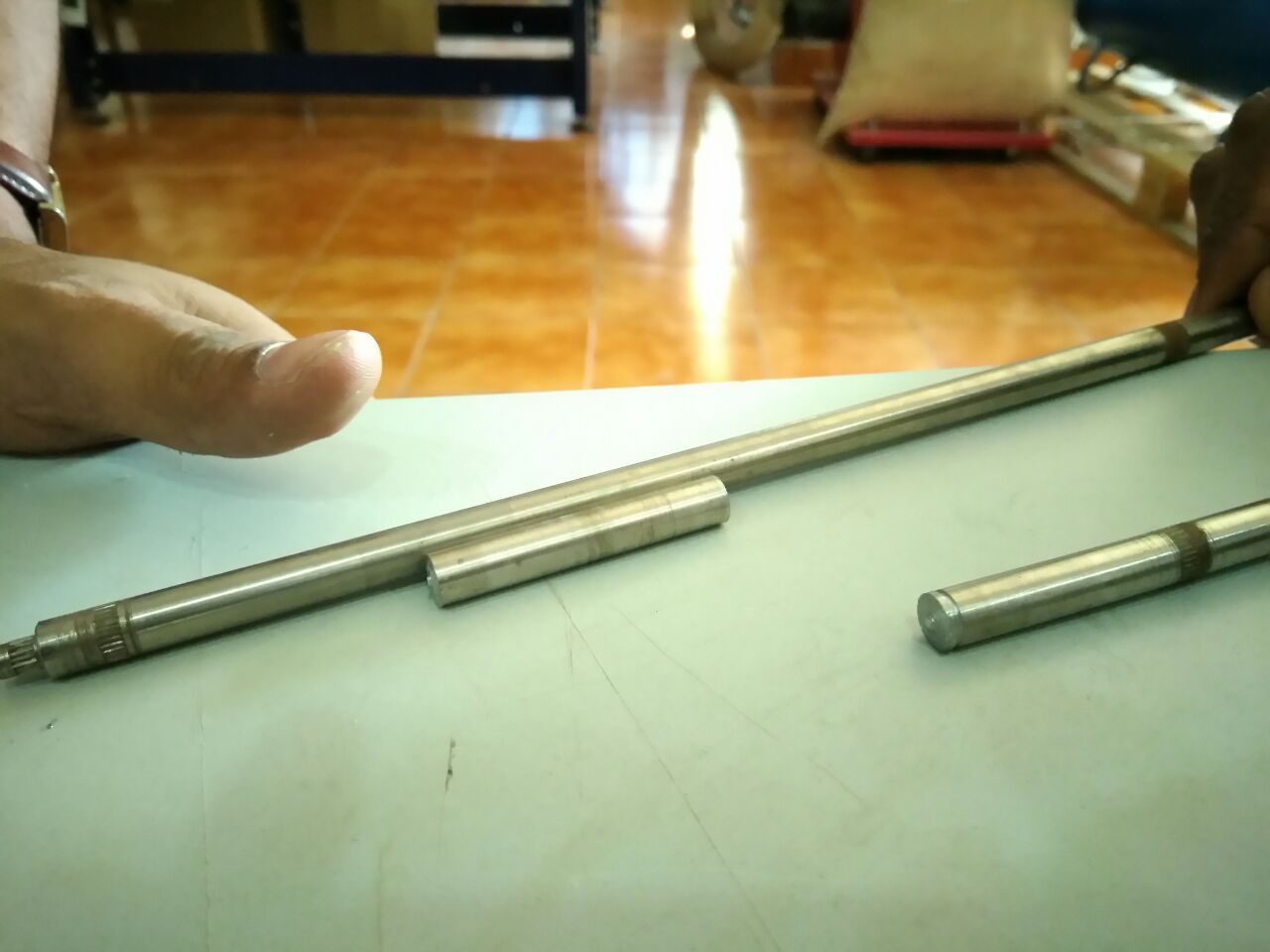
Ajith try to see if it fits, and it did..
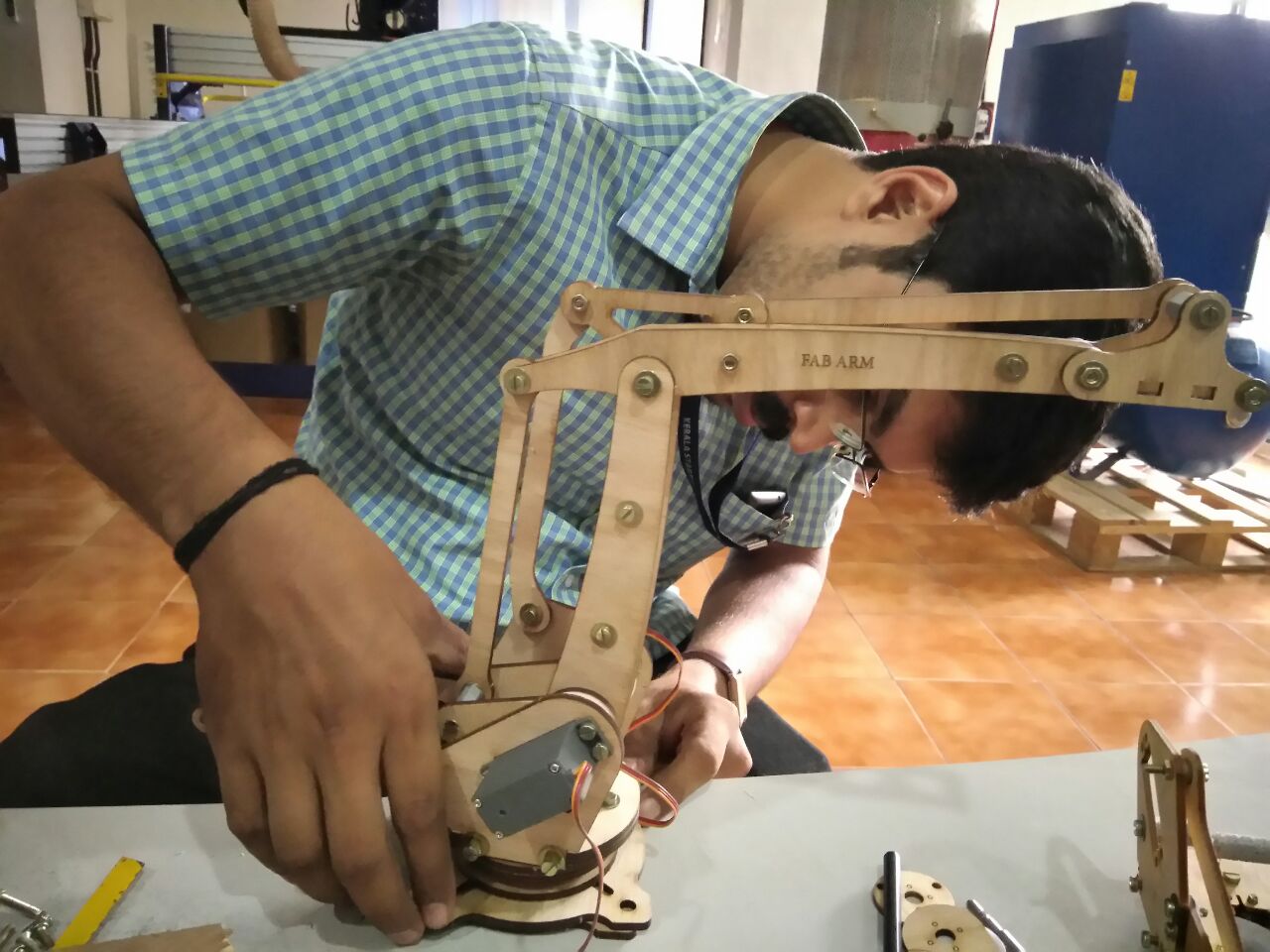
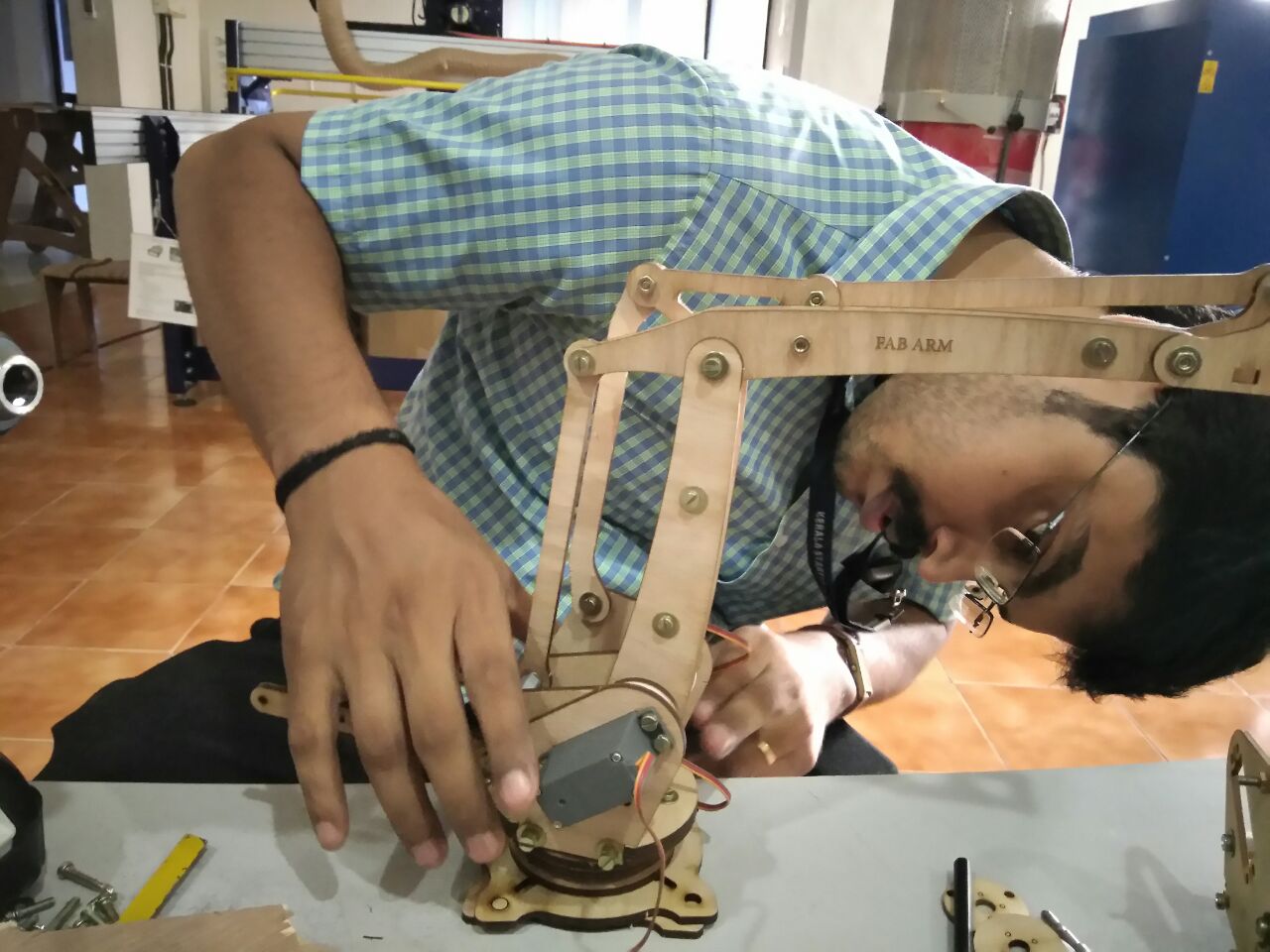
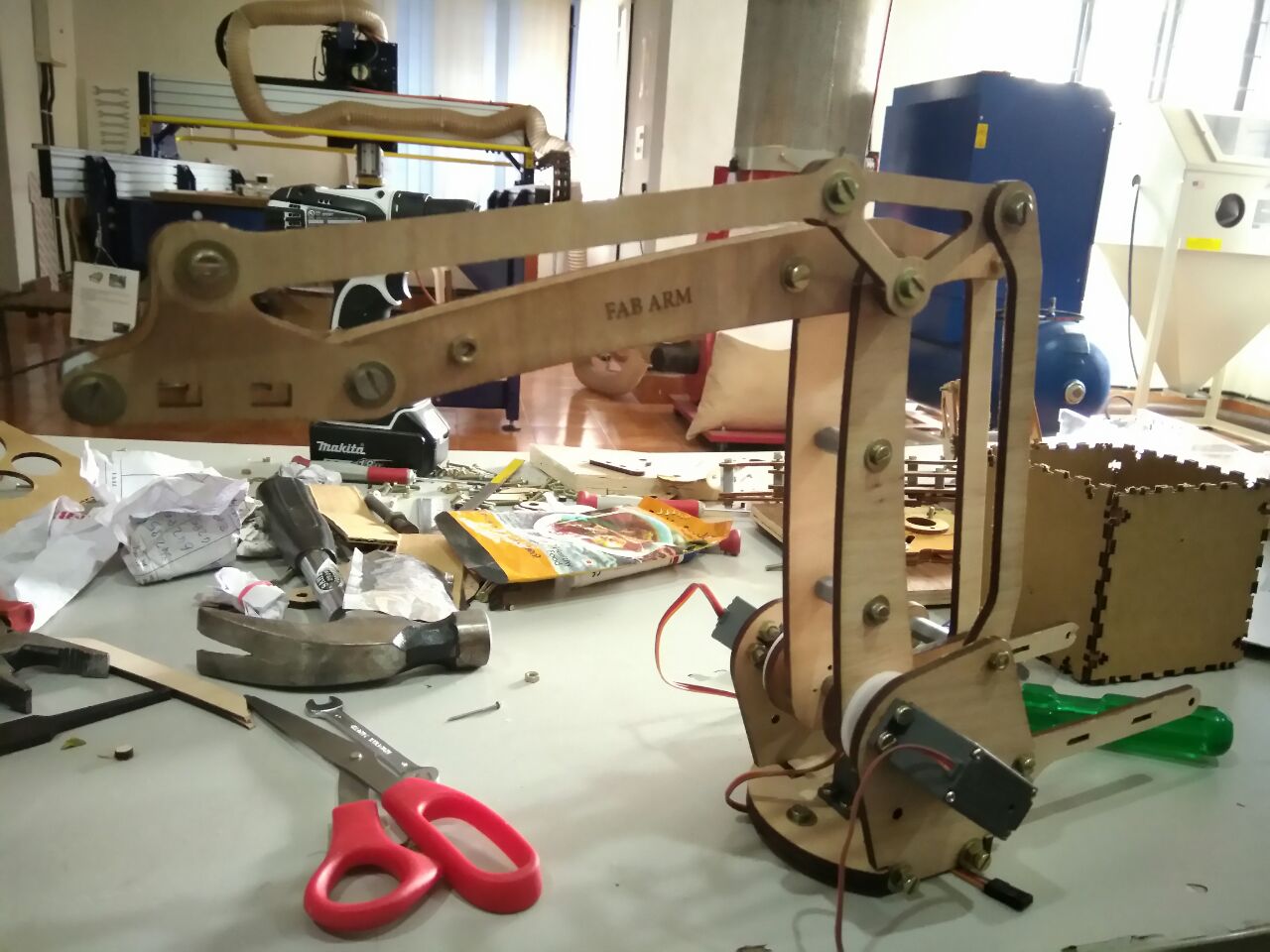
I completed the rest of the assembly and the fab arm is complete.
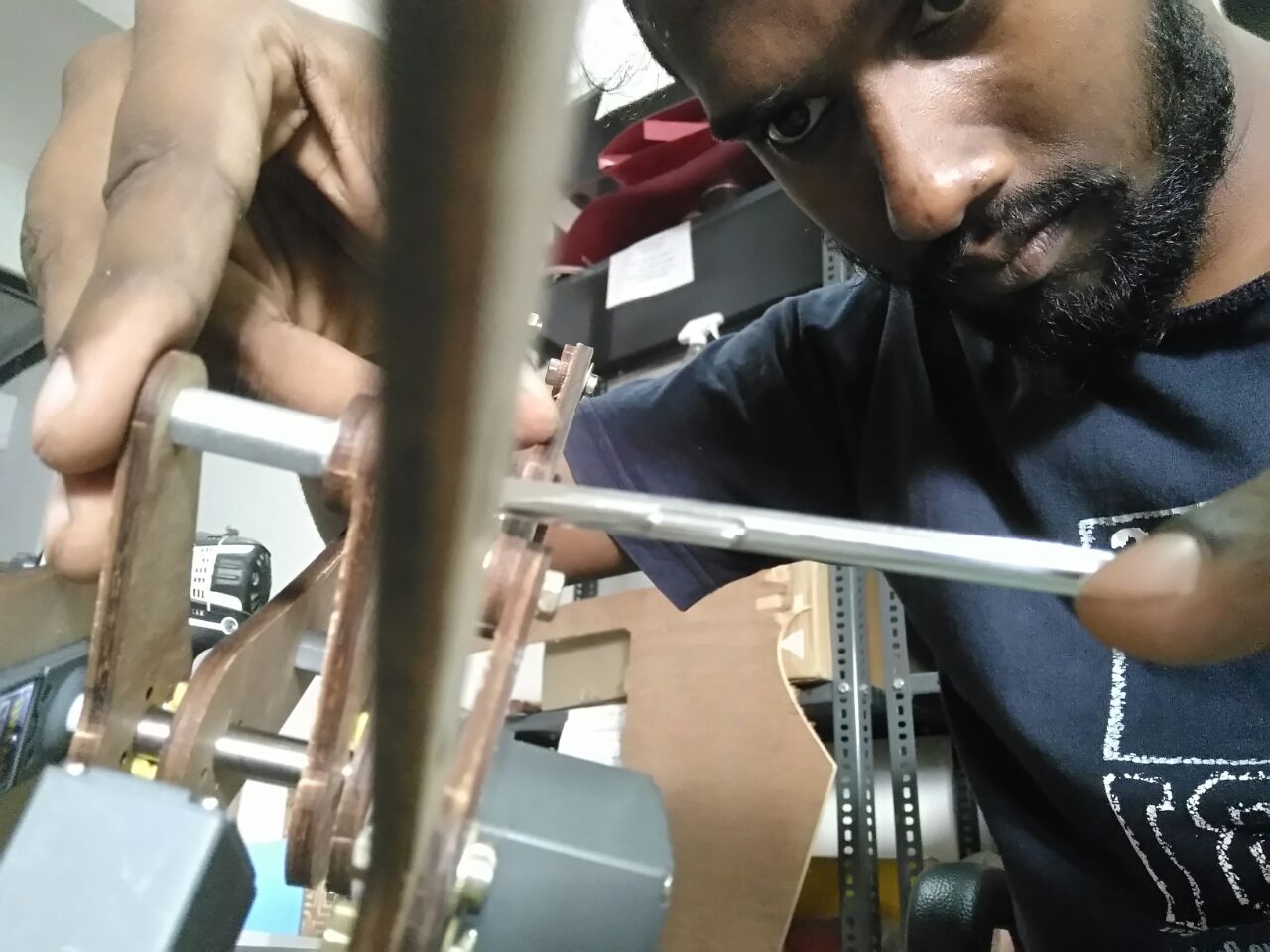
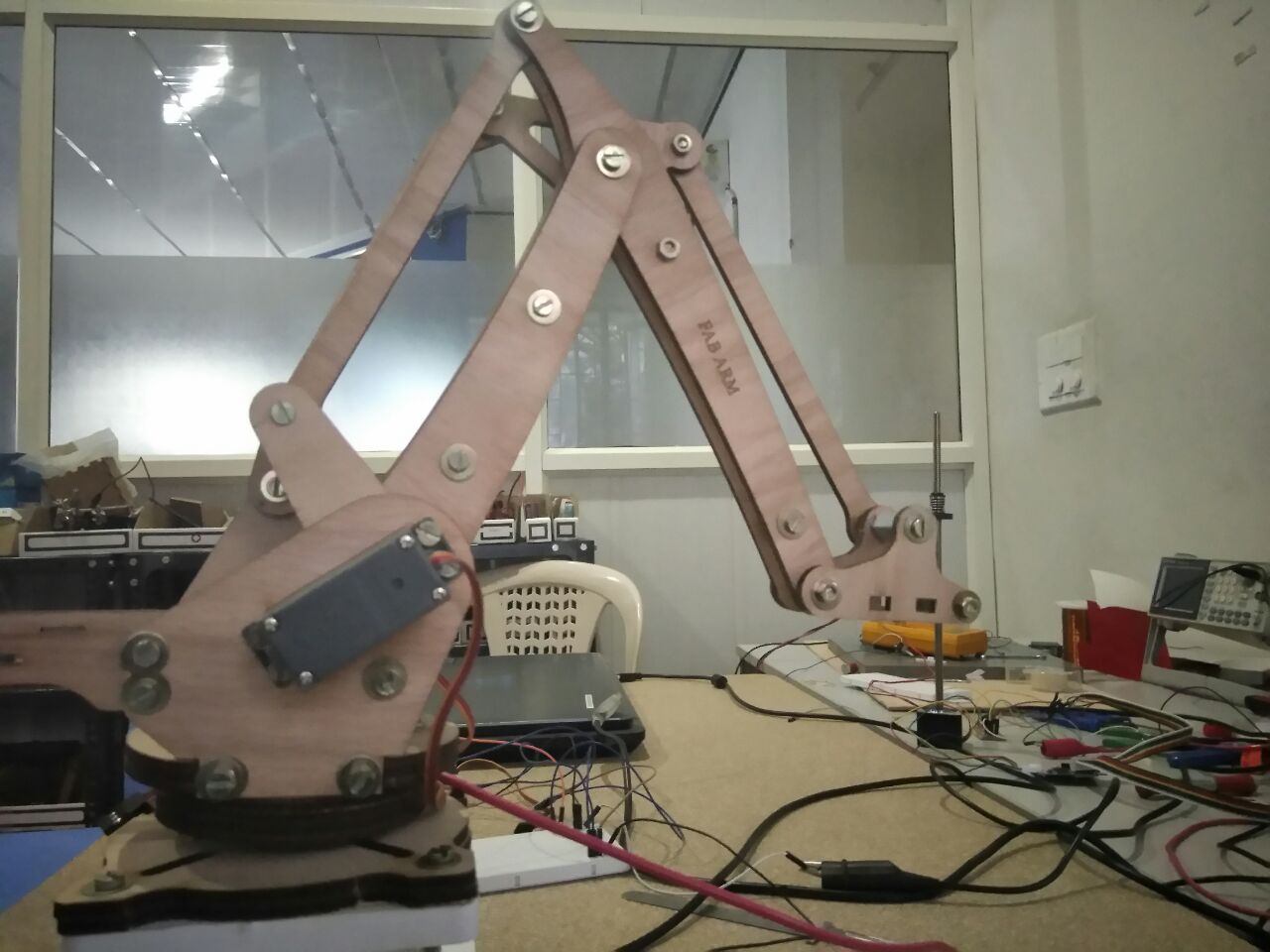
I also worked on the control integration and UI design. Pic Courtsey: Ajith
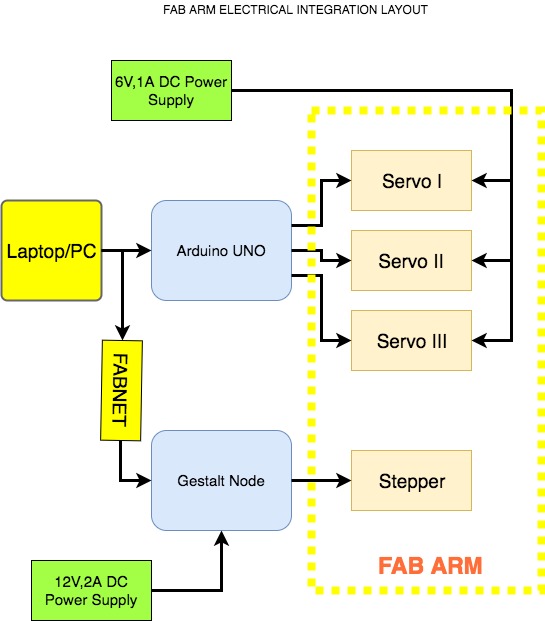
I started off with the fabnet usb design to power the fab arm and to communicate via ftdi.

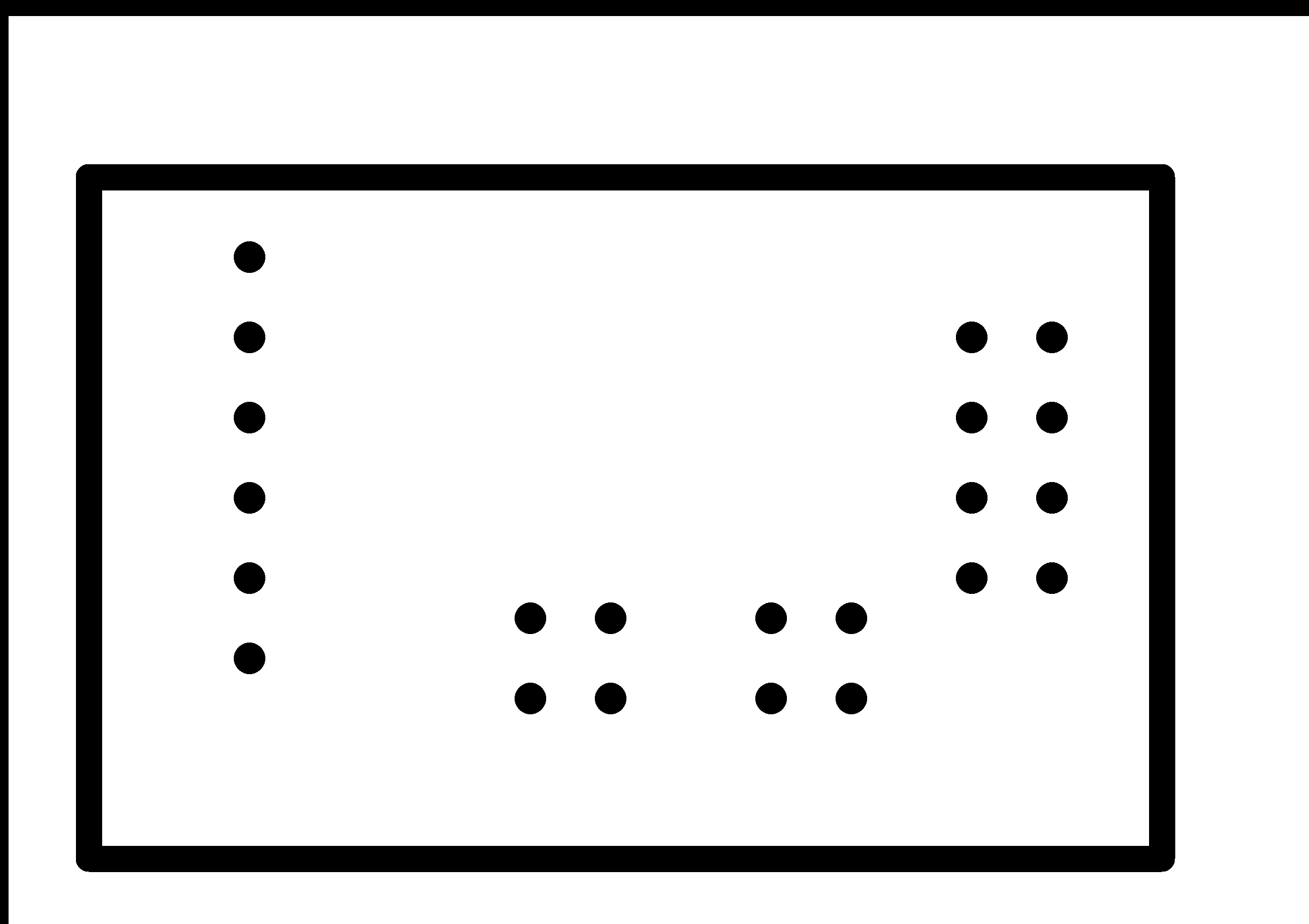
But my soldering wasn't quite good and the traces came off, and we had to desolder everything and do another board.
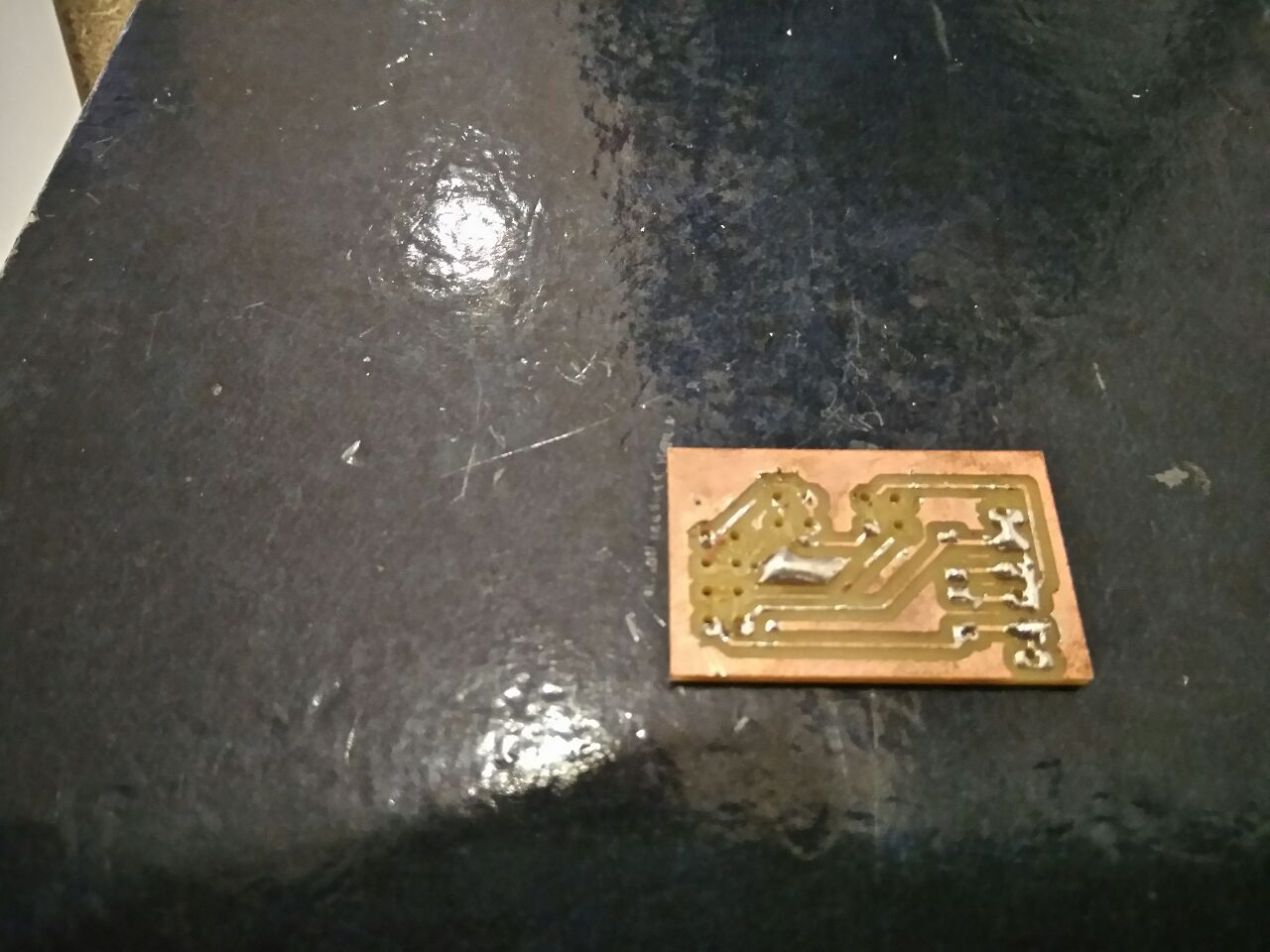
This time we did this board based on existing design,
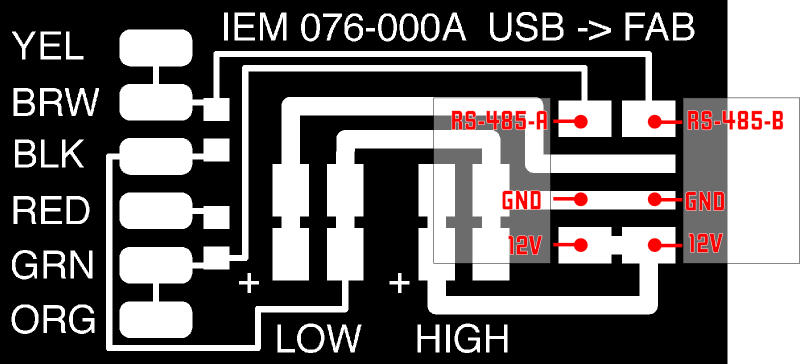
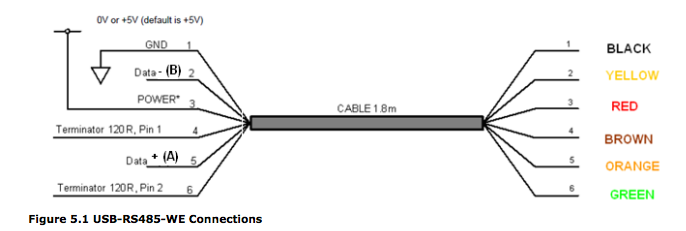
The fabnet board we created,
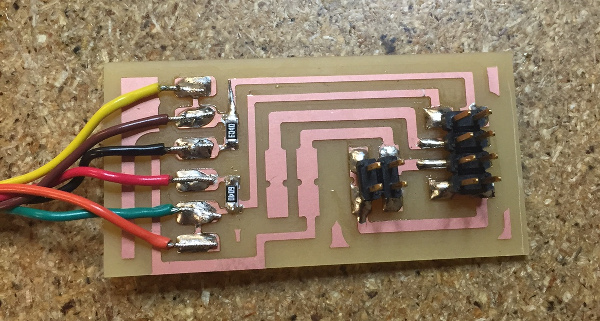
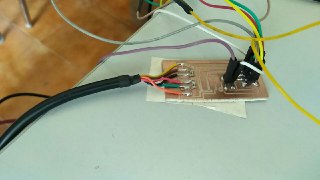
I used the fabnet to test the gestalt boards and worked towards integrating multiple stepper motors via gestalt.
We used the stepper motor to drive the fabarm through the guide rail that Rahul did using Jen's design,
With that done, I started with the arduino code to control the fabarm. We could not use the stepper motors to drive the fab arm elbows because the whole structure could not support the weight of the stepper motors. We used the arduino code to control the servo motors, which I had help from Renjith to get it properly communicating serially,
//add servo library
#include < Servo.h>
//define our servos
Servo servo1;
Servo servo2;
Servo servo3;
//Servo servo4;
//define our potentiometers
//int pot1 = A0;
//int pot2 = A1;
//int pot3 = A2;
//int pot4 = A3;
//variable to read the values from the analog pin (potentiometers)
int valPot1 = 120;
int valPot2 = 90;
int valPot3 = 90;
//int valPot4;
char inByte;
void setup()
{ Serial.begin(9600);
//attaches our servos on pins PWM 3-5-6-9 to the servos
servo1.attach(9);
servo1.write(valPot1); //define servo1 start position
servo2.attach(10);
servo2.write(valPot2); //define servo2 start position
servo3.attach(11);
servo3.write(valPot3); //define servo3 start position
// servo4.attach(6);
// servo4.write(70); //define servo4 start position
}
void loop()
{
//reads the value of potentiometers (value between 0 and 1023)
// while (1);
// valPot1 = analogRead(pot1);
// valPot1 = map (valPot1, 0, 1023, 100, 180); //scale it to use it with the servo (value between 0 and 180)
// servo1.write(valPot1); //set the servo position according to the scaled value
////-------------------------------------------------------------
// valPot2 = analogRead(pot2);
// valPot2 = map (valPot2, 0, 1023, 0, 180);
// servo2.write(valPot2);
// //-----------------------------------------------------------------
// valPot3 = analogRead(pot3);
// valPot3 = map (valPot3, 0, 1023, 45, 130);
// servo3.write(valPot3);
//
// valPot4 = analogRead(pot4);
// valPot4 = map (valPot4, 0, 1023, 70, 150);
// servo4.write(valPot4);
if (Serial.available())
{
inByte = Serial.read();
switch (inByte) {
case 'a':
Serial.print("a");
valPot1 += 1;
servo1.write(valPot1);
Serial.println(" ");
break;
case 'b':
Serial.print("b");
valPot2 += 1;
servo2.write(valPot2);
Serial.println(" ");
break;
case 'c':
Serial.print("c");
valPot3 += 1;
servo3.write(valPot3);
Serial.println(" ");
break;
case 'd':
Serial.print("d");
valPot1 -= 1;
servo1.write(valPot1);
Serial.println(" ");
break;
case 'e':
Serial.print("e");
valPot2 -= 1;
servo2.write(valPot2);
Serial.println(" ");
break;
case 'f':
Serial.print("f");
valPot3 -= 1;
servo3.write(valPot3);
Serial.println(" ");
break;
case 's':
Serial.print(byte(valPot1));
Serial.print(" ");
Serial.print(byte(valPot2));
Serial.print(" ");
Serial.print(byte(valPot3));
Serial.println(" ");
break;
case '\n':
break;
default:
Serial.print("Wrong Input");
Serial.println(" ");
}
}
}
We used the arduino code to do a cleaning like action,
Along the same timeline, I worked on the GUI based on kivy. I used the sample code from Gestalt library to get started.
from kivy.uix.popup import Popup
from kivy.app import App
from kivy.uix.gridlayout import GridLayout
from kivy.uix.label import Label
from kivy.uix.textinput import TextInput
from kivy.uix.button import Button
from kivy.uix.boxlayout import BoxLayout
from kivy.uix.stacklayout import StackLayout
from kivy.uix.slider import Slider
from kivy.config import Config
Config.set('modules', 'serial', '')
# Forked from DFUnitVM Oct 2013
# set portname
# set location of hex file for bootloader
#
#------IMPORTS-------
from pygestalt import nodes
from pygestalt import interfaces
from pygestalt import machines
from pygestalt import functions
from pygestalt.machines import elements
from pygestalt.machines import kinematics
from pygestalt.machines import state
from pygestalt.utilities import notice
from pygestalt.publish import rpc #remote procedure call dispatcher
import time
import io
import threading
import serial
#------VIRTUAL MACHINE------
class virtualMachine(machines.virtualMachine):
def initInterfaces(self):
if self.providedInterface: self.fabnet = self.providedInterface #providedInterface is defined in the virtualMachine class.
else: self.fabnet = interfaces.gestaltInterface('FABNET', interfaces.serialInterface(baudRate = 115200, interfaceType = 'ftdi', portName = '/dev/tty.usbserial-FT0METG6'))
def initControllers(self):
self.xAxisNode = nodes.networkedGestaltNode('X Axis', self.fabnet, filename = '086-005a.py', persistence = self.persistence)
self.xNode = nodes.compoundNode(self.xAxisNode)
def initCoordinates(self):
self.position = state.coordinate(['mm'])
def initKinematics(self):
self.xAxis = elements.elementChain.forward([elements.microstep.forward(4), elements.stepper.forward(1.8), elements.leadscrew.forward(6.096), elements.invert.forward(True)])
self.stageKinematics = kinematics.direct(1) #direct drive on all axes
def initFunctions(self):
self.move = functions.move(virtualMachine = self, virtualNode = self.xNode, axes = [self.xAxis], kinematics = self.stageKinematics, machinePosition = self.position,planner = 'null')
self.jog = functions.jog(self.move) #an incremental wrapper for the move function
pass
def initLast(self):
# self.machineControl.setMotorCurrents(aCurrent = 0.8, bCurrent = 0.8, cCurrent = 0.8)
# self.xyzNode.setVelocityRequest(0) #clear velocity on nodes. Eventually this will be put in the motion planner on initialization to match state.
pass
def publish(self):
# self.publisher.addNodes(self.machineControl)
pass
def getPosition(self):
return {'position':self.position.future()}
def setPosition(self, position = [None]):
self.position.future.set(position)
def setSpindleSpeed(self, speedFraction):
# self.machineControl.pwmRequest(speedFraction)
pass
class FabControl(GridLayout):
def __init__(self, **kwargs):
super(FabControl, self).__init__(**kwargs)
self.cols = 3
self.row = 3
global serialcom, tempmotor1, tempmotor2, tempmotor3
tempmotor1 = 120
tempmotor2 = 90
tempmotor3 = 90
serialcom = serial.Serial()
serialcom.braudrate = 115200
serialcom.port = "/dev/tty.usbmodem1421"
serialcom.open()
self.add_widget(Label(text='Motor1 [ 0 to 120 ] '))
self.motor1 = Slider(min=-30, max=120, value=120)
self.motor1.bind(value=self.Motor1Change)
self.add_widget(self.motor1)
self.motor1value = Label(text=str(self.motor1.value))
self.add_widget(self.motor1value)
self.add_widget(Label(text='Motor2 [ 0 to 180 ] '))
self.motor2 = Slider(min=0, max=180, value=90)
self.motor2.bind(value=self.Motor2Change)
self.add_widget(self.motor2)
self.motor2value = Label(text=str(self.motor2.value))
self.add_widget(self.motor2value)
self.add_widget(Label(text='Motor3 [ 45 to 130 ] '))
self.motor3 = Slider(min=45, max=130, value=90)
self.motor3.bind(value=self.Motor3Change)
self.add_widget(self.motor3)
self.motor3value = Label(text=str(self.motor3.value))
self.add_widget(self.motor3value)
self.add_widget(Label(text='Motor4 [ -100 to 100 ] '))
self.motor4 = Slider(min=-100, max=100, value=0)
self.motor4.bind(value=self.Motor4Change)
self.add_widget(self.motor4)
self.motor4value = Label(text=str(self.motor4.value))
self.add_widget(self.motor4value)
self.move = Button(text="Move")
self.add_widget(self.move)
self.move.bind(on_press=self.initiatemove)
self.startrec = Button(text="Start Record")
self.add_widget(self.startrec)
self.stoprec = Button(text="Stop Record")
self.add_widget(self.stoprec)
self.play = Button(text="Play")
self.add_widget(self.play)
def Motor4Change(self, instance, value):
self.motor4value.text = str(value)
def Motor1Change(self, instance, value):
self.motor1value.text = str(value)
threading.Thread(target=self.movemotor1).start()
def Motor2Change(self, instance, value):
self.motor2value.text = str(value)
threading.Thread(target=self.movemotor2).start()
def Motor3Change(self, instance, value):
self.motor3value.text = str(value)
threading.Thread(target=self.movemotor3).start()
def initiatemove(self,instance):
# time.sleep(5)
threading.Thread(target=self.movemotor4).start()
threading.Thread(target=self.movemotor1).start()
threading.Thread(target=self.movemotor2).start()
threading.Thread(target=self.movemotor3).start()
def movemotor4(self):
print "movemotor4 called"
global stage
# print stage
# print self.motor4.value
# print self.motor1.value
# print self.motor2.value
# print self.motor3.value
#
movemotor4 = int(self.motor4.value)
supercoords = [[movemotor4]]
for coords in supercoords:
stage.move(coords, 0)
status = stage.xAxisNode.spinStatusRequest()
while status['stepsRemaining'] > 0:
time.sleep(0.001)
status = stage.xAxisNode.spinStatusRequest()
# ser = serial.Serial()
# ser.braudrate = 115200
# ser.port = "/dev/tty.usbmodem1411"
# ser.open()
def movemotor1(self):
print "movemotor1called"
global serialcom, tempmotor1
movemotor1 = self.motor1.value - tempmotor1
tempmotor1 = self.motor1.value
print movemotor1
# print movemotor2
# print movemotor3
if serialcom.isOpen():
print("serialcomial is open!")
# serialcom.write('a\n')
if movemotor1 > 0:
for i in range(int(movemotor1)):
print 'sending a'
serialcom.write('a\n')
# time.sleep(.5)
# print serialcom.read()
print serialcom.readline()
else:
for i in range(abs(int(movemotor1))):
serialcom.write('d\n')
# time.sleep(.5)
# print serialcom.read()
print serialcom.readline()
# serialcom.close()
def movemotor2(self):
print "movemotor2called"
global serialcom, tempmotor2
movemotor2 = self.motor2.value - tempmotor2
tempmotor2 = self.motor2.value
print movemotor2
if serialcom.isOpen():
print("serialcomial is open!")
# serialcom.write('a\n')
if movemotor2 > 0:
for i in range(int(movemotor2)):
print 'sending b'
serialcom.write('b\n')
# time.sleep(.5)
# print serialcom.read()
print serialcom.readline()
else:
for i in range(abs(int(movemotor2))):
serialcom.write('e\n')
# time.sleep(.5)
# print serialcom.read()
print serialcom.readline()
def movemotor3(self):
print "movemotor3called"
global serialcom, tempmotor3
movemotor3 = self.motor3.value - tempmotor3
tempmotor3 = self.motor3.value
print movemotor3
if serialcom.isOpen():
print("serialcomial is open!")
# serialcom.write('a\n')
if movemotor3 > 0:
for i in range(int(movemotor3)):
print 'sending c'
serialcom.write('c\n')
# time.sleep(.5)
# print serialcom.read()
print serialcom.readline()
else:
for i in range(abs(int(movemotor3))):
serialcom.write('f\n')
# time.sleep(.5)
# print serialcom.read()
print serialcom.readline()
class FabApp(App):
def build(self):
global stage
stage = virtualMachine()
# print dir(stage.xNode)
#stage.xNode.loadProgram('../../../086-005/086-005a.hex')
#stage.xNode.setMotorCurrent(1)
stage.xNode.setVelocityRequest(8)
return FabControl()
if __name__ == '__main__':
FabApp().run()
To run the python kivy program, kivy fabarmkivy.py
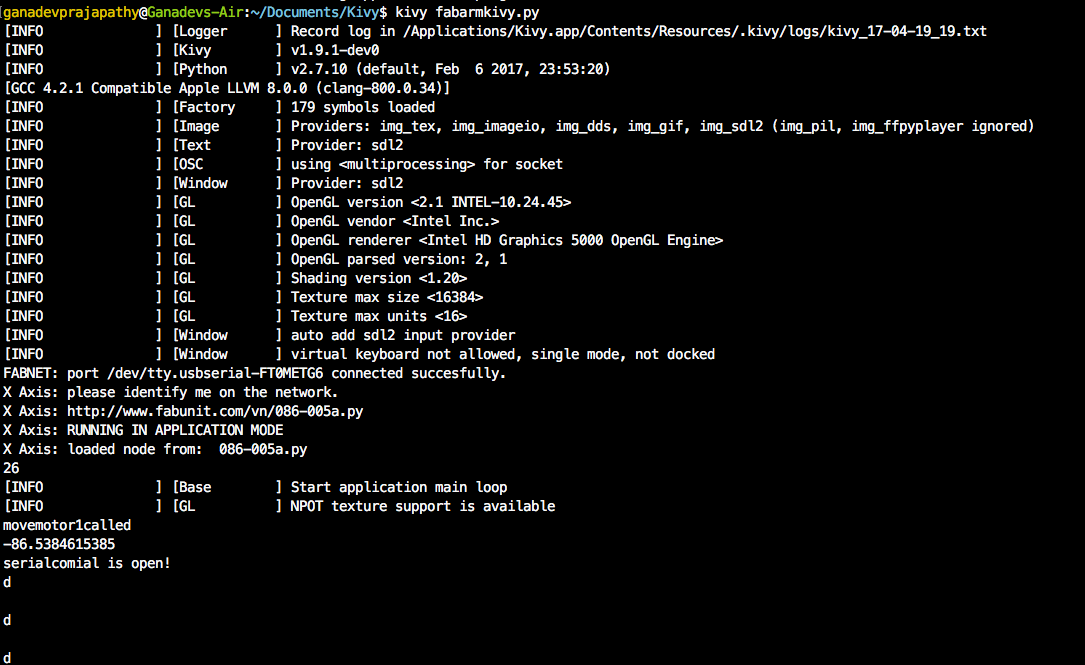
Screenshot of the UI,
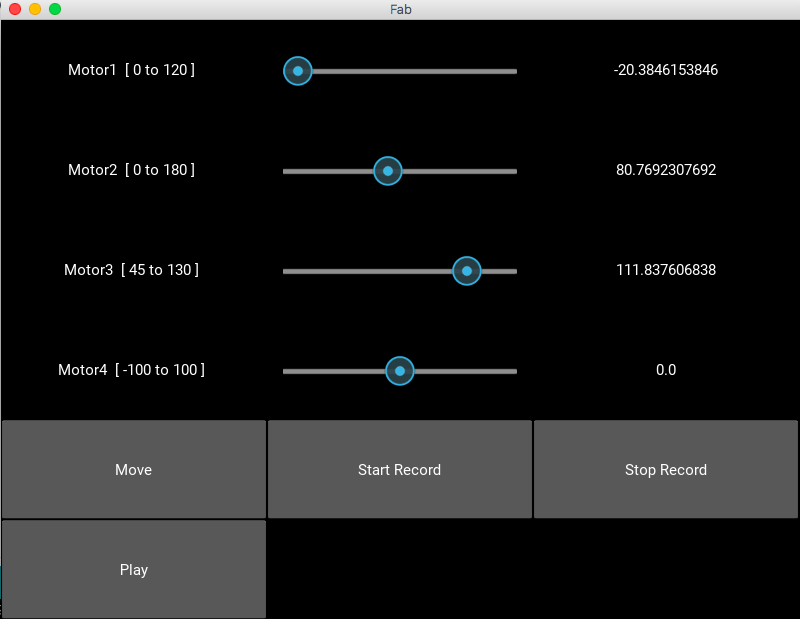
It took me a while because it wasn't quite working as intended by the code, it was too jittery and random, sometimes it moves correct sometimes doesn't
Finally figure it was due to some loose connections and I replaced the servos as well during debugging,
Controlling via GUI
Download the files
fabarmkivy.py
fabarminterface.ino
FabNetTrace.png
FabNetCut.png